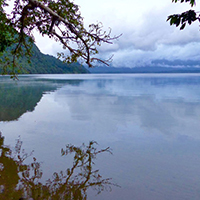Testate amoebae (Amoebozoa: Arcellinidae) as indicators of dissolved oxygen concentration and water depth in lakes of the Lacandón Forest, southern Mexico
Testate amoebae from Lacandón Forest lakes, Mexico

Submitted: 16 August 2019
Accepted: 11 December 2019
Published: 16 December 2019
Accepted: 11 December 2019
Abstract Views: 1325
PDF: 580
HTML: 63
HTML: 63
Publisher's note
All claims expressed in this article are solely those of the authors and do not necessarily represent those of their affiliated organizations, or those of the publisher, the editors and the reviewers. Any product that may be evaluated in this article or claim that may be made by its manufacturer is not guaranteed or endorsed by the publisher.
All claims expressed in this article are solely those of the authors and do not necessarily represent those of their affiliated organizations, or those of the publisher, the editors and the reviewers. Any product that may be evaluated in this article or claim that may be made by its manufacturer is not guaranteed or endorsed by the publisher.
Similar Articles
- Nobuaki Kimura, Wen-Cheng Liu, Jeng-Wei Tsai, Chih-Yu Chiu, Timothy K. Kratz, Akira Tai, Contribution of extreme meteorological forcing to vertical mixing in a small, shallow subtropical lake , Journal of Limnology: Vol. 76 No. 1 (2017)
- Feng Li, Gang Yang, Yonghong Xie, Xinsheng Chen, Zhengmiao Deng, Jiayu Hu, Competition between two wetland macrophytes under different levels of sediment saturation , Journal of Limnology: Vol. 74 No. 3 (2015)
- Rocco Tiberti, Rossana Caroni, Massimiliano Cannata, Andrea Lami, Dario Manca, Daniele Strigaro, Michela Rogora, Automated high frequency monitoring of Lake Maggiore through in situ sensors: system design, field test and data quality control , Journal of Limnology: Vol. 80 No. 2 (2021)
- Jong-Yun Choi, Kwang-Seuk Jeong, Geung-Hwan La, Kwang-Hyeon Chang, Gea-Jae Joo, The influence of aquatic macrophytes on distribution and feeding habit of two Asplanchna species (A. priodonta and A. herrickii) in shallow wetlands, South Korea , Journal of Limnology: Vol. 74 No. 1 (2015)
- Claudia Dresti, Andrea Fenocchi, Diego Copetti, Modelling physical and ecological processes in medium-to-large deep European perialpine lakes: a review , Journal of Limnology: Vol. 80 No. 3 (2021): Celebratory Issue - 80th Anniversary of the Journal of Limnology
- Michela Rogora, Martina Austoni, Rossana Caroni, Paola Giacomotti, Lyudmila Kamburska, Aldo Marchetto, Rosario Mosello, Arianna Orru', Gabriele Tartari, Claudia Dresti, Temporal changes in nutrients in a deep oligomictic lake: the role of external loads versus climate change , Journal of Limnology: Vol. 80 No. 3 (2021): Celebratory Issue - 80th Anniversary of the Journal of Limnology
- Maxine A.D. Mowe, Simon M. Mitrovic, Richard P. Lim, Ambrose Furey, Darren C.J. Yeo, Tropical cyanobacterial blooms: a review of prevalence, problem taxa, toxins and influencing environmental factors , Journal of Limnology: Vol. 74 No. 2 (2015)
- Alicja Bonk, Wojciech Tylmann, Benjamin Amann, Dirk Enters, Martin Grosjean, Modern limnology and varve-formation processes in Lake Żabińskie, northeastern Poland: comprehensive process studies as a key to understand the sediment record , Journal of Limnology: Vol. 74 No. 2 (2015)
- Michael A. Figueroa-Sanchez, Nandini Sarma, S.S.S. Sarma, Zooplankton community structure in the presence of low levels of cyanotoxins: a case study in a high altitude tropical reservoir (Valle de Bravo, Mexico) , Journal of Limnology: Vol. 73 No. 1 (2014)
- Robert Sturm, Modelling ecological specificities of freshwater molluscs: the exemplary case of Bythinella austriaca (v. Frauenfeld, 1857) (Gastropoda, Prosobranchia) , Journal of Limnology: Vol. 75 No. 3 (2016)
<< < 4 5 6 7 8 9 10 11 12 13 > >>
You may also start an advanced similarity search for this article.

 https://doi.org/10.4081/jlimnol.2019.1936
https://doi.org/10.4081/jlimnol.2019.1936





